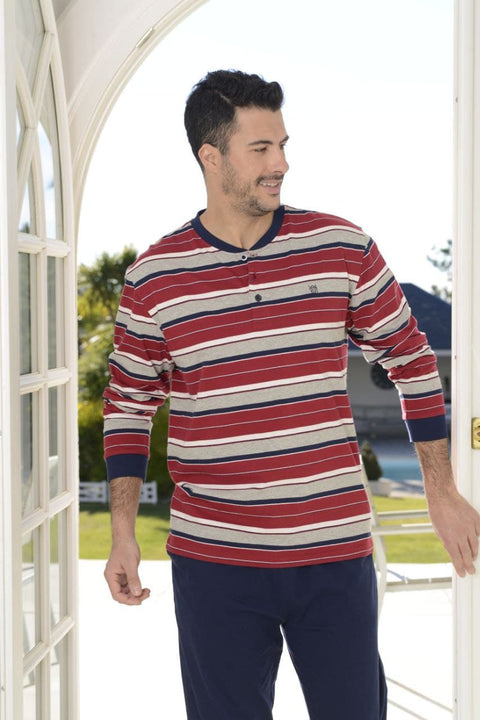Pajamas and Designers
The Evolution of Men's Pajamas
Boxers and a t-shirt , that's how most men have dressed for bed since they ditched their childhood soccer pajamas. Occasionally, if it is cold enough, you can wear a pair of thin cotton pants.
The Current Preference of Young People
As far as you can tell, it seems to be the same behavior with everyone younger in the current generation: an old t-shirt paired with a pair of shorts or pants. A 2004 survey by ABC News found that only 13 percent of men wore pajamas, and with a clear trend toward decline. So, the question should be asked: What happened to pajamas? What is known about those formal two-piece suits that evoke images of Dick Van Dyke or Desi Arnaz?
The Persistence of Pajamas
According to design historians, pajamas are definitely not dead. Somewhere, right now, high-priced pajama sets must be being sold to someone. There are even some more affordable versions, but whether today's men use them or not is a separate question. According to a study by pajama company Sleep Jones , only half of their customers wear their pajamas to bed.
Pajamas as a Fashion Statement
"Pajamas are more of a fashion statement now," note fashion and design historians at The New School. They add that they are still part of what is considered "a gentleman's wardrobe," and explain that they are more likely to be These garments are found in the closets of upper-class citizens, while average middle-class young people simply opt for boxers and a t-shirt.
History of Pajamas
Origins in India
Originally, pajamas, or pajamas as they are spelled outside the United States, came from Indian fashion. During the days of the British Empire, the colonists looked at these lightweight drawstring pants and thought they looked great, so they brought them back to England with them. Soon, among the upper class, pajamas would be paired with a matching jacket to replace the nightgown.
The Nightshirt
Before pajamas, men and women essentially wore the same thing to bed. This outfit was a long shirt that extended almost to the floor. For the lower classes, the shirt could have been a little shorter, as it could very well have been the same shirt they worked in during the day.
The Popularization of Pajamas
The Pajama Set and Dressing Gown
Soon, these novel pajamas would match the dressing gown that already existed, better known as the dressing gown. This outfit became the popular garment among the wealthy when visiting family or close friends in their homes. They were made of beautiful fabrics and had intricate designs, becoming a status symbol throughout Europe and America.
The 20th Century and the Evolution of Pajamas
For the lower class, the nightshirt would persist as the primary nightwear until a few decades into the 20th century, as it would remain the warmest way to dress in a home, predating central heating. With a high collar, full sleeves, and a medium or longer shin, the nightshirt was warmer than a two-piece pajama set. It wouldn't be until the 1920s that pajamas would begin to make their way into the mainstream.
The 1950s
In the 1950s, elegant pajamas were being replaced by more comfortable and informal styles made of elastic knit fabrics on top and fine cotton cloth trousers. Basically, with cheaper fabrics came greater accessibility, and by the 1950s, the nightgown had long been dead.
The 70s and 80s
In the 1970s, however, things changed. There was a resurgence of grandpa-style nightgowns and pajama sets with shiny satin robes. This decade also saw the birth of multi-purpose clothing during the disco era, with clothing that could be worn at work and in the club. Sportswear soon emerged, where clothing intended for the gym began to be worn in public, especially during the 1980s and beyond.
The Breaking of the Dress Rules
Along with this break in dress code, the pajama set would become a casualty. During the 1950s and 1960s, a working-class man could come home and fall into an aristocrat-like routine, in which he would take off his suit and put on a sweater, before changing once again to go. to the bed. However, as the pace of life quickened, the popularity of pajamas eroded. From the 1970s and 1980s onwards, men were more likely to come home and put on a pair of sweatpants or shorts. There wasn't much reason to change again after that.
The Opinion of the Designers
The Rise of Democracy in Fashion
While some may see this as a breaking of norms, design experts point out that a sexier way to put it is that it reflects the rise of democracy. As the conversion to a more open society increases and the walls of class crumble, pomp and formality accompany it. Examples include billionaires like Steve Jobs and Mark Zuckerberg, who would never be known to be rich if you didn't know their faces.
The Return of Elegance
Perhaps, then, in a time when many believe democracy is eroding, pajamas could make a comeback? Well, maybe. Today, there is something the fashion industry calls the “return of elegance,” where formality is making a comeback. For years, men's fashion runways have been walked by men in hoodies and sweatpants, but as an antidote to that, some designers have gone the other way. There's nothing else you can do with sweatpants. Perhaps the pendulum will be seen swinging in the other direction and more formal attire may return.
So while our future may soon seem like an Orwellian nightmare, at least we can have some nice pajamas to try to sleep in.
To discover more about pajamas and sleepwear fashion, visit our store at El Búho Nocturno.

